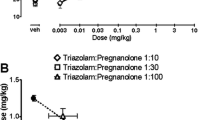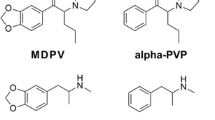Abstract
Previous research has found that drugs with affinity for ω (benzodiazepine) sites differ in their abilities to produce tolerance and dependence. The present study therefore investigated the effects of ligands of ω (BZ) sites in rats that had been rendered tolerant to a benzodiazepine. Two experiments were carried out in separate groups of rats. Behavioral changes induced by chronic infusion of triazolam (3 mg/kg/day, SC, for 14 days) via osmotic pumps were studied in animals trained on a fixed ratio 10 schedule of food presentation. Control animals were implanted with pumps containing the vehicle. Test drugs were administered IP using cumulative dosing. In one experiment triazolam decreased response rates on days 1, 2 and 3 after implantation of the pumps and tolerance developed to this depressant effect. In the other experiment, vehicle and triazolam treated rats differed in their responding during chronic infusion but differences were not statistically significant on any particular day. Flumazenil (3.0–30 mg/kg) greatly decreased rates of responding on day 11 in triazolam treated rats. This effect may represent a precipitated withdrawal syndrome. However, no withdrawal effects on operant performance were observed upon pump removal. Chronic infusion of triazolam did not affect the sensitivity of rats to alpidem on day 11 (10–100 mg/kg) whereas it abolished the stimulant effect of bretazenil (0.1–1.0 mg/kg). Chronic triazolam treatment produced tolerance to the depressant effects of triazolam (1.0–3.0 mg/kg), lorazepam (0.3–3.0 mg/kg) and zopiclone (10 mg/kg) but no tolerance to those of CL 218,872 (3.0–30 mg/kg) and zolpidem (0.3–3.0 mg/kg) when tested 3–14 days after pump removal. Differences between compounds highlighted with this model are in agreement with previous observations that these agents possess different pharmacological profiles and different potentials to induce tolerance and dependence.
Similar content being viewed by others
References
Adams JU, Holtzman SG (1990) Tolerance and dependence after continuous morphine infusion from osmotic pumps measured by operant responding in rats. Psychopharmacology 100:451–458
Ator NA, Griffiths RR (1992) Oral self-administration of triazolam, diazepam and ethanol in the baboon: drug reinforcement and benzodiazepine physical dependence. Psychopharmacology 108:301–312
Beardsley PM, Balster RL, Harris LS (1986) Dependence on tetrahydrocannabinol in rhesus monkeys. J Pharmacol Exp Ther 239:311–319
Benavides J, Peny B, Durand A, Arbilla S, Scatton B (1992) Comparative in vivo and in vitro regional selectivity of ω (benzodiazepine) site ligands inhibiting [3H] flumazenil binding in the rat central nervous system. J Pharmacol Exp Ther 263:1033–1041
Carroll ME, Lac ST (1987) Cocaine withdrawal produces behavioral disruptions in rats. Life Sci 40:2183–2190
Carroll ME, Hagen EW, Ascencio M, Brauer LM (1988) Behavioral dependence on caffeine and phencyclidine in rhesus monkeys: interactive effects. Pharmacol Biochem Behav 31:927–932
Cook L, Sepinwall J (1975) Behavioral analysis of the effects and mechanisms of action of benzodiazepines. In: Costa E. Greengard P (eds) Mechanisms of action of benzodiazepines. Raven, New York, pp 1–28
Corfield-Sumner PK, Stolerman IP (1978) Behavioral tolerance. In: Blackman DE, Sanger DJ (eds) Contemporary research in behavioral pharmacology. Plenum, New York, pp 391–448
Corrigall WA, Herling S, Coen KM (1989) Evidence for a behavioral deficit during withdrawal from chronic nicotine treatment. Pharmacol Biochem Behav 33:559–562
Cox A, Boyland P, Gent JP, Feely M (1988) Investigation of anti-convulsant tolerance to zolpidem in mice. Br J Pharmacol 95:667P
Cumin R, Bonetti EP, Scherschlicht R, Haefely WE (1982) Use of the specific benzodiazepine antagonist, Ro 15-1788, in studies of physiological dependence on benzodiazepines. Experientia 38:833–834
Depoortere H, Zivkovic B, Lloyd KG, Sanger DJ, Perrault G, Langer SZ, Bartholini G (1986) Zolpidem, a novel non-benzodiazepine hypnotic. I. Neuropharmacological and behavioral effects. J Pharmacol Exp Ther 237:649–658
Doble A, Martin IL (1992) Simple benzodiazepine receptors: no reason for anxiety. Trends Pharmacol Sci 13:76–81
Emmett-Oglesby MW, Mathis DA, Moon RTY, Lal H (1990) Animal models of drug withdrawal symptoms. Psychopharmacology 101:292–309
File SE (1981) Rapid development of tolerance to the sedative effects of lorazepam and triazolam in rats. Psychopharmacology 73:240–245
File SE (1982) Development and retention of tolerance to the sedative effects of chlordiazepoxide: role of apparatus cues. Eur J Pharmacol 81:637–642
File SE (1985) Tolerance to the behavioral actions of benzodiazepines. Neurosci Biobehav Rev 9:113–121
Gent JP, Bentley M, Feely M, Haigh JRM (1986) Benzodiazepine cross- tolerance in mice extends to sodium valproate. Eur J Pharmacol 128:9–15
Goldberg SR, Schuster CR (1969) Morphine increased sensitivity of monkeys formerly dependent on morphine. Science 166:1548–1549
Goudie AJ, Demellweek C (1986) Conditioning factors in drug tolerance. In: Goldberg SR, Stolerman IP (eds) The behavioral basis of drug dependence. Academic Press, NY, pp 225–285
Goudie AJ, Leathley MJ (1992) Effects of the 5-HT3 antagonist ondansetron on benzodiazepine-induced “operant behavioural dependence” in rats. Psychopharmacology 109:461–465
Greeley J, Cappell H (1985) Associate control of tolerance to the sedative and hypothermic effects of chlordiazepoxide. Psychopharmacology 90:513–521
Griffiths JW, Goudie AJ (1987) Analysis of the role of behavioural factors in the development of tolerance to the benzodiazepine midazolam. Neuropharmacology 26:201–209
Griffiths RR, Lamb RJ, Ator NAD, Roache J, Brady JV (1985) Relative abuse liability of triazolam: experimental assessment in animals and humans. Neurosci Biobehav Rev 9:133–151
Griffiths RR, Sannerud CA, Ator NA, Brady JV (1992) Zolpidem behavioral pharmacology in baboons: self-injection, discrimination, tolerance and withdrawal. J Pharmacol Exp Ther 260:1199–1208
Haefely W, Martin JR, Schoch P (1990) Novel anxiolytics that act as partial agonists at benzodiazepine receptors. Trends Pharmacol Sci 11:452–456
Haigh JRM, Feely M (1988) Tolerance to the anticonvulsant effect of benzodiazepines. Trends Pharmacol Sci 9:361–366
Herberg LJ, Montgomery AMJ (1987) Learnt tolerance to sedative effects of chlordiazepoxide on self-stimulation performance, but no tolerance to facilitatory effects after 80 days. Psychopharmacology 93:214–217
Holtzman SG, Villarreal JE (1973) Operant behavior in the morphine-dependent rhesus monkey. J Pharmacol Exp Ther 184:528–541
Julou L, Bardone MC, Blanchard JC, Garrett C, Stutzman JM (1983) Pharmacological studies on zopiclone. Pharmacology 27 [Suppl 2]: 46–58
Julou L, Blanchard JC, Dreyfus JF (1985) Pharmacological and clinical studies of cyclopyrrolones: zopiclone and suriclone. Pharmacol Biochem Behav 23:653–659
King DA, Bouton ME, Musty RE (1987) Associative control of tolerance to the sedative effects of a short-acting benzodiazepine. Behav Neurosci 101:104–114
Lamb RJ, Griffiths RR (1985) Effects of repeated Ro 15-1788 administration in benzodiazepine-dependent baboons. Eur J Pharmacol 110:257–261
Lamb RJ, Griffiths RR (1987) Effects of Ro 15-1788 and CGS 8216 in diazepam dependent baboons. Eur J Pharmacol 143:205–212
Langer SZ, Arbilla S, Scatton B, Niddam R, Dubois A (1988) Receptors involved in the mechanism of action of zolpidem. In: Sauvanet JP, Langer SZ, Morselli PL (eds) Imidazopyridines in sleep disorders. Raven, New York, pp 55–70
Lippa AS, Coupet J, Greenblatt EN, Klepner CA, Beer B (1979) A synthetic non-benzodiazepine ligands for benzodiazepine receptors: a probe for investigating neuronal substrates of anxiety. Pharmacol Biochem Behav 11:99–106
Löscher W, Hönack D (1992) Withdrawal precipitation by benzodiazepine receptor antagonists in dogs chronically treated with diazepam or the novel anxiolytic and anticonvulsant β-carboline abecarnil. Naunyn-Schmiedeberg's Arch Pharmacol 345:452–460
Lucki I, Kucharik RF (1990) Increased sensitivity to benzodiazepine antagonists in rats following chronic treatment with a low dose of diazepam. Psychopharmacology 102:350–356
Margules DL, Stein L (1968) Increase of “antianxiety” activity and tolerance of behavioral depression during chronic administration of oxazepam. Psychopharmacologia 13:74–80
McElroy JF, Fleming RL, Feldman RS (1985) Comparison between chlordiazepoxide and CL 218,872 — a synthetic non-benzodiazepine ligand for benzodiazepine receptors on spontaneous locomotor activity in rats. Psychopharmacology 85:224–226
McMillan DE, Leander JD (1978) Chronic chlordiazepoxide and pentobarbital interactions on punished and unpunished behavior. J Pharmacol Exp Ther 207:515–520
Miller LG, Greenblatt DJ, Barnhill JG, Shader RI (1988a) Chronic benzodiazepine administration. I. Tolerance is associated with benzodiazepine receptor downregulation and decreased γ-aminobutyric acidA receptor function. J Pharmacol Exp Ther 246:170–176
Miller LG, Greenblatt DJ, Roy RB, Summer WR, Shader RI (1988b) Chronic benzodiazepine administration. II. Discontinuation syndrom is associated with up-regulation of γ-aminobutyric acidA receptor complex binding and function. J Pharmac Exp Ther 246:177–182
Moreau JL, Jenck F, Pieri L, Schoch P, Martin JR, Haefely WE (1990) Physical dependence induced in DBA/2J mice by benzodiazepine receptor full agonists, but not by the partial agonist Ro 16-6028. Eur J Pharmacol 190:269–273
Perrault G, Morel E, Sanger DJ, Zivkovic B (1990) Pharmacological profiles of four new hypnotics with different chemical structures: quazepam, brotizolam, zopiclone and zolpidem. Eur J Pharmacol 187:487–494
Perrault G, Morel E, Sanger DJ, Zivkovic B (1992) Lack of tolerance and physical dependence upon repeated treatment with the novel hypnotic zolpidem. J Pharmacol Exp Ther 263:298–303
Perrault G, Morel E, Sanger DJ, Zivkovic B (1993) Repeated treatment with alpidem, a new anxiolytic, does not induce tolerance or physical dependence. Neuropharmacology 32:855–863
Rosenberg HC, Tietz EI, Chiu TH (1991) Differential tolerance to the antipentylenetetrazol activity of benzodiazepines in flurazepam-treated rats. Pharmacol Biochem Behav 39:711–716
Ruhland M (1985) Metaclazepam — a new anxiolytic benzodiazepine with selective tolerance and cross tolerance to other benzodiazepines. Pharmacopsychiatry 18:22–23
Sanger DJ, Zivkovic B (1987) Investigation of the development of tolerance to the actions of zolpidem and midazolam. Neuropharmacology 26:1513–1518
Sanger DJ, Zivkovic B (1992) Differential development of tolerance to the depressant effects of benzodiazepine and non-benzodiazepine agonists at the omega (BZ) modulatory sites of GABAA receptors. Neuropharmacology 31:693–700
Sanger DJ, Perrault G, Morel E, Joly D, Zivkovic B (1987) The behavioral profile of zolpidem, a novel hypnotic drug of imidazopyridine structure. Physiol Behav 41:235–240
Sanger DJ, Perrault G, Morel E, Joly D, Zivkovic B (1993a) The psychopharmacological profile of alpidem. In: Bartholini G, Garreau M, Morselli PL, Zivkovic B (eds) Imidazopyridines in anxiety disorders: a novel experimental and therapeutic approach. Raven, New York, pp 73–84
Sanger DJ, Benavides J, Perrault G, Morel E, Cohen C, Joly D, Zivkovic B (1994) Recent developments in the behavioral pharmacology of benzodiazepine (ω) receptors: evidence for the functional significance of receptor subtypes. Neurosci Biobehav Rev (in press)
Sannerud CA, Marley RJ, Serdikoff SL, Alastra AJG, Cohen C, Goldberg SR (1993) Tolerance to the behavioral effects of chlordiazepoxide: pharmacological and biochemical selectivity. J Pharmacol Exp Ther (in press)
Spealman RD (1986) Disruption of schedule-controlled behavior by Ro 15-1788 one day after acute treatment with benzodiazepines. Psychopharmacology 88:398–400
Steppuhn KG, Schneider HH, Turski L, Stephens DN (1993) Long-term treatment with abecarnil does not induce diazepam-like dependence in mice. J Pharmacol Exp Ther 264:1395–1400
Takada K, Suzuki T, Hagen T, Cook JM, Katz JL (1989) Behavioral effects of benzodiazepine antagonists in chlordiazepoxide tolerant and non-tolerant rats. Life Sci 44:289–299
Wessinger WD, Owens SM (1991) Phencyclidine dependence: the relationship of dose and serum concentrations to operant behavioral effects. J Pharmacol Exp Ther 258:207–215
Winer BJ (1971) Statistical principles in experimental design. McGraw-Hill, New York, pp 529–532
Woods JH, Katz JL, Winger G (1987) Abuse liability of benzodiazepines. Pharmacol Rev 39:251–419
Woods JH, Katz JL, Winger G (1992) Benzodiazepines: use, abuse and consequences. Pharmacol Rev 44:151–347
Zivkovic B, Perrault G, Sanger DJ (1992) Receptor subtype-selective drugs: a new generation of anxiolytics and hypnotics. In: Langer S, Mendlewicz J, Racagni G (eds) Target receptors for anxiolytics and hypnotics: from molecular pharmacology to therapeutics. Karger, Basel, pp 55–73
Author information
Authors and Affiliations
Rights and permissions
About this article
Cite this article
Cohen, C., Sanger, D.J. Tolerance, cross-tolerance and dependence measured by operant responding in rats treated with triazolam via osmotic pumps. Psychopharmacology 115, 86–94 (1994). https://doi.org/10.1007/BF02244756
Received:
Revised:
Issue Date:
DOI: https://doi.org/10.1007/BF02244756




